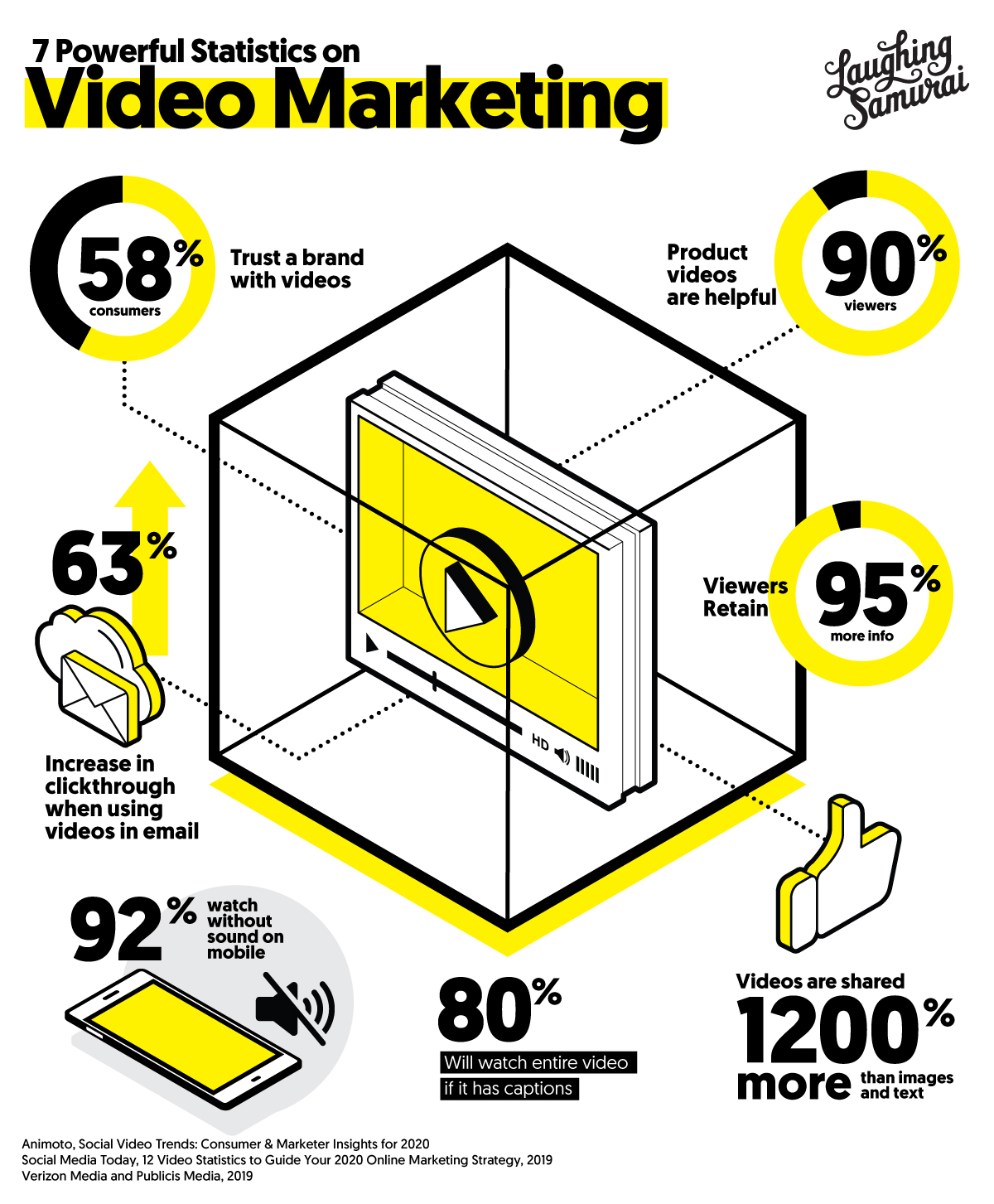To remain competitive in today’s market, marketers must place importance on making video a key component of their brand’s marketing strategy, from sharing videos on social media to hosting them on a video platform to newer forms such as Instagram Stories. In fact, 58 percent of consumers trust a brand with videos more than a brand without. Now is the time to find creative ways to market your business using video.
Still unconvinced? Let us throw some stats at you:
- 90 percent of video viewers say product videos are helpful in the decision-making process. (Social Media Today)
- Video marketing in email increases the Clickthrough rate by 63 percent. (Social Media Today)
- Videos are shared on social media 1200 percent more than images and text combined. (Social Media Today)
- 78% of people watch online videos every week, and 55% view online videos every day. (HubSpot)
- Viewers retain 95% of a message when they watch it in a video, compared to 10% when reading it in text. (Insivia)
Define Your Goal
Before you implement video into your marketing strategy, it is important to define what you hope your video will accomplish. Are you looking to promote a new product or service? Educate potential and existing customers? It is easy to lose focus without an understanding of what your goals are. Defining them early on will allow you to create content that resonates with your audience in a significant way.
Define Your Target Audience
A mistake many marketers do is assume that their content resonates with every demographic. Whether you like it or not, you can’t be everything to everyone. In order for your content to perform well, you need to know exactly who you’re looking to target. Consider the age, location, and income of your target, for example, as well as how your product or service can solve their unique problem. Defining your target audience will give you insight into what their specific needs are and how best to meet them.
Share An Emotional Story That Will Elicit A Response
Storytelling is an intrinsic human characteristic that dates all the way back our caveman days to when we were sitting around a fire trying to get our point across with cave paintings. Many of us have an inclination to visual learning, and video lends itself as a particularly effective tool to communicate a good story.
According to Vidyard, stories make for better marketing because they elicit emotion, influence who we trust, play on nostalgia, and help us make sense of a complex situation. In fact, Psychology Today shared that brands are getting emotional in their video marketing because emotions compel action, with emotional ads being almost twice as effective as those with only rational content.
A great example of successful use of video is Levi Strauss & Co.’s 2017 “Circles” ad. The 90-second spot (and a personal favorite) features the pulsing beats of the song “Makeba” by artist Jain, and a diverse cast of characters, all unified by their love of dancing and Levi’s. “Men. Women. Young. Old. Rich. Poor. Gay. Straight. Let’s live how we dance. Live in Levi’s,” flashes on-screen at the end of the video. The video’s popularity led it to become one of the ten most-watched ads on YouTube.
Keep It Simple
As our attention spans continue to shrink, it is important to take note of the average attention spans across different social media platforms. According to Animoto, your video should be just as long as it needs to be in order to get your information across, and not a second longer. Your videos should be clear, concise, and entertaining, communicating a few simple ideas in a memorable way. When you keep your videos simple and entertaining, they will perform better for your brand.
Make Sure Your Video Works Without Sound
A survey of U.S. consumers found that 92% view videos with the sound off on mobile and 83% watch with sound off. The report recommends that advertisers caption their advertisements because 80% of consumers are more likely to watch an entire video when captions are available.
There are many reasons why someone might watch a video without sound. They might be at work, on public transportation, standing in line, or they might be hard-of-hearing or deaf. Knowing this, it is important to think about how you can ensure your videos are engaging when they are being played silently.
An easy way to create a compelling story without the need for audio is by using enticing visuals and colorful subtitles or closed-captioning to explain what is happening. NowThis, the social media news organization, was one of the pioneers of using short videos with text, which were easily shareable on Twitter and Facebook. If a viewer chose to watch the video without audio, they would not miss anything.
Optimize For Search Engines
Don’t forget to give your videos the same attention you’d give a blog post or landing page! Search Engine Watch recommends providing a transcription to your uploads on video platforms, so it will appear on search engines; optimizing your video file metadata with related and user intent keywords on the video’s title and description, and creating a video sitemap and submitting it to Google Search Console.
Make Videos Mobile Responsive
If you are reading this on your phone, you’ve probably consumed video on mobile before. A survey conducted by Facebook found that people are 1.5 times more likely to watch videos on smartphones than on computers. Responsive video platforms such as YouTube and Vimeo will automatically increase or decrease video quality according to bandwidth. Additionally, it is important to keep an eye out for text size, because while it might appear large on a television screen, it might look incredibly small on a smartphone screen.
Insert a Call-To-Action
A clear call-to-action makes it as easy as possible for your audience to take the next step in their journey, from being redirected to your website, social media channels, registering for a newsletter or signing up for a trial. Use YouTube end screens to include clickable elements your audience can interact with once the video ends, or if you’re posting on social media make sure to include a link to click or swipe up leading users to your landing page.
Final Thoughts
Video marketing should be a key component within your marketing strategy. It is a great tool to break down concepts, help your potential and existing customers to learn more about your service or product, and create content that can be repurposed in the future. It takes effort to create high-performing videos, but with the right hosting them on a video platform and the right video marketing strategy, you’ll be building deeper relationships with your audience and generating leads in no time.


